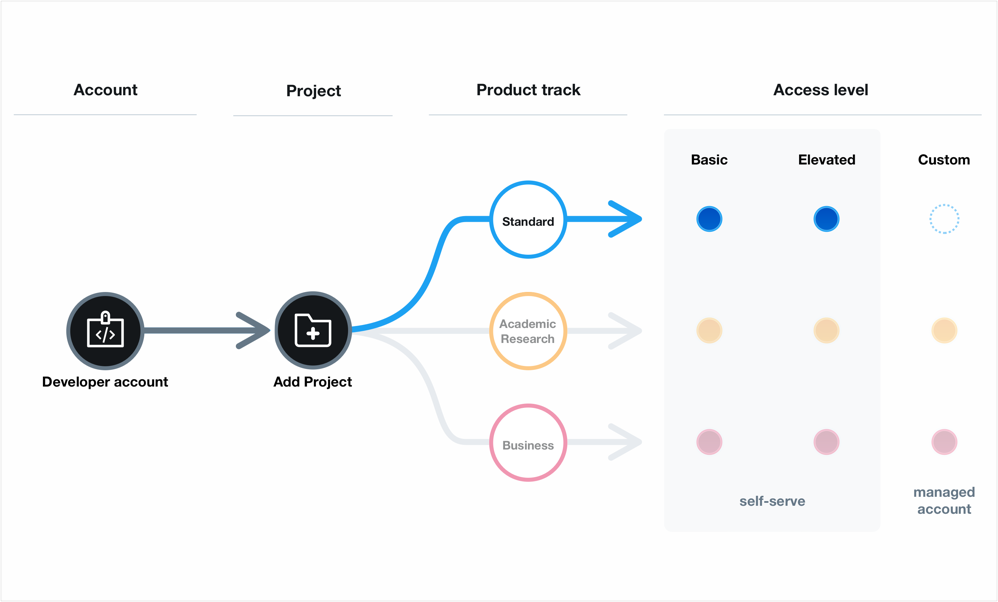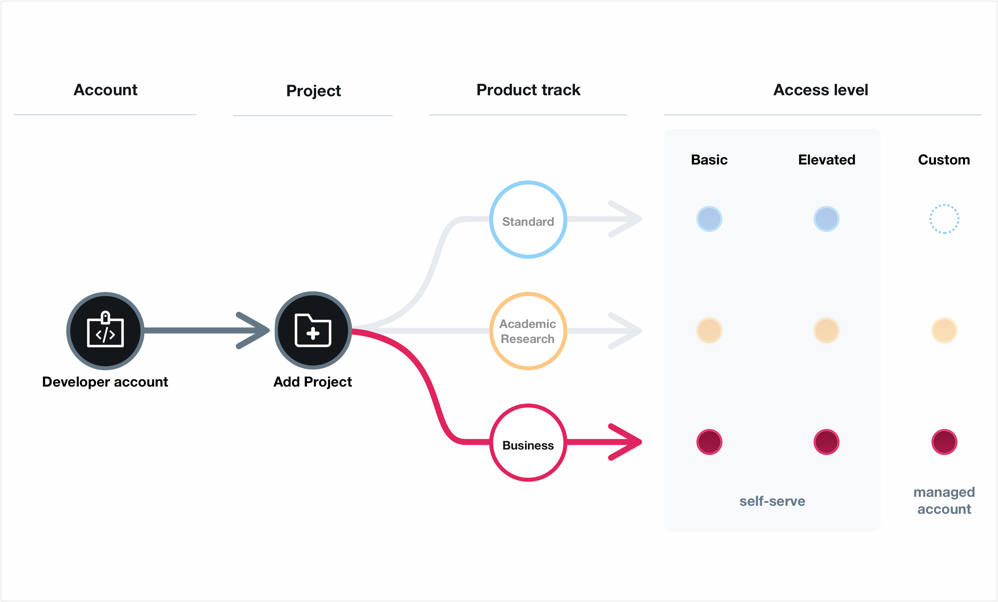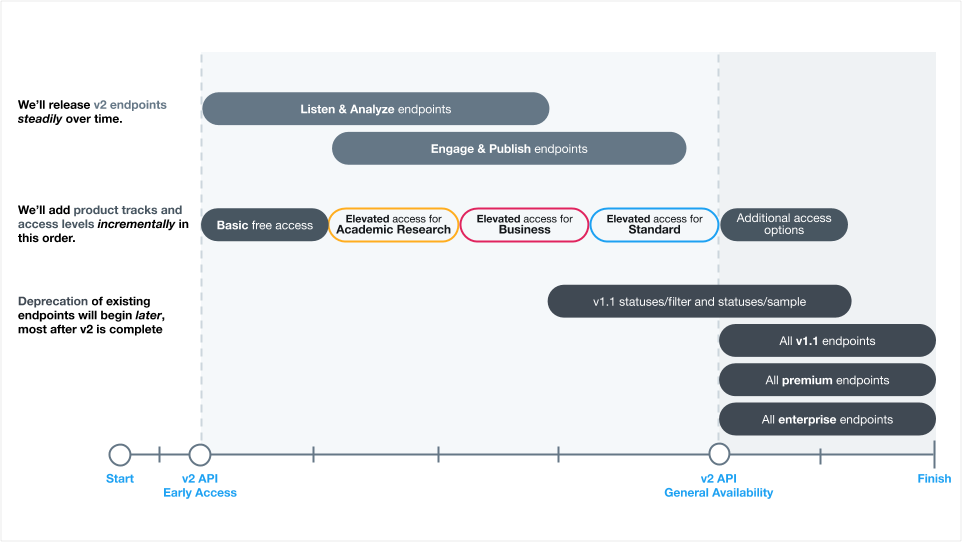Early Access
Guide to the future of the Twitter API
Overview
At Twitter, our purpose is to serve the public conversation and we believe developers play a critical role in achieving this. Twitter wouldn’t be what it is today if it weren’t for you. Your creativity and work with our API make Twitter, and the world, a better place.
We’re building the next generation of the Twitter API to better serve our diverse community of developers. Our API gives you the ability to learn from and engage with the conversation on Twitter and we want to give you tools to further uncover, build on, and share the value of this conversation with the world.
To serve our diverse ecosystem, we plan to introduce a few new concepts and components to the platform. Consider this page your guide to the future of the Twitter API. As we build, we’ll update our product roadmap and will be keeping you updated here about the details of our plans. And with our new API foundation, we'll be better able to incorporate your feedback and make improvements along the way.
If you missed our recent announcements, make sure to read our blog posts introducing the new and improved Twitter API, and the Academic Research product track. If you have questions, feedback, or suggestions about any of the following, let us know.
Last updated: January 26, 2021
Support for diverse use cases
We’ve always known that our developer ecosystem is diverse, but our API has long taken a one-size-fits-all approach. You helped us to understand the use cases you have when you work with the Twitter API and we're building the new API to help support these use cases—releasing new functionality in phases, each supporting the core use cases that we’ve heard from you.
Understanding the global conversation
Our first few releases will be focused on making it easier to understand the public conversation. One of the most common reasons developers use the Twitter API is to listen to and analyze the conversation happening on Twitter. We’re not done yet. In the coming months, we will continue to release additional endpoints to help you understand the conversation, to discover insights, or to make informed decisions.
Engaging with people on Twitter
People come to Twitter to connect and interact with each other, with their favorite teams, celebrities, or musicians, with world leaders, with their communities, with brands, with fun bots, and more. Developers play a critical role in creating content and engaging in various ways on the platform. In the coming months, we’ll release a number of endpoints (including new versions of endpoints for creating Tweets) to Early Access to support these use cases.
Improving Twitter
Developers have played a key part in making Twitter healthier and more engaging since the beginning. Your love for Twitter shows through your work and we want to make it easy for you to channel your passion for Twitter into actively making it better. We want to empower you to give people more control over their experience on Twitter.
The new Academic Research product track represents a crucial beginning to this process, as their research and discoveries can help make the world a better place, even help improve experiences on Twitter. Although we started with academic researchers, keep an eye open for new endpoints, guidance, and tools to fuel this kind of work across our Standard, Academic Research, and Business product tracks.
New access options to get started and grow
Your feedback helped us see the importance of making the new Twitter API more flexible and scalable to fit your needs. With the new API, we are building new access options and product tracks so more developers can find options to support their use cases.
Access levels
Within the new Twitter API, we intend to introduce three core access levels which make it easy to grow and scale. The three access levels include:
- Basic access: Free, default access to endpoints for developers with an approved developer account. Based on research over the past few years, we expect that the large majority of developers (>80%) will find the access they need within this tier to get started and build something awesome.
- Elevated access: Increased access to collections of relevant endpoints that include access to more Tweets, increased rate limits, and more advanced reliability features.
- Custom access: While the majority of developers’ goals will be met by Basic and Elevated access, for those who need more, we can help get you what you need.
Product tracks
We love the incredible diversity of developers who use our API. And we want to provide a platform that:
serves many types of developers with access and tools that fit their use cases
continues to offer free and open access for developers, and
provides a dedicated and supported path for both commercial and non-commercial services built with the API
To accomplish these, we're introducing new, distinct product tracks to better serve different groups of developers and provide them with a tailored experience and support, a range of relevant access levels, and appropriate pricing (where applicable).
Developers who already have a developer account will start in the Standard product track and will be able to apply for others. New developers will be able to apply for the tracks that are relevant to you.
Standard: The default product track for most developers, including those building something for fun, for a good cause, to learn or teach.
Academic Research: Academic researchers are one of the largest groups looking to understand what’s happening in the public conversation. Within this track, qualified academic researchers will get increased levels of access to a relevant collection of endpoints, including a new full-archive search endpoint. We’re also providing resources for researchers to make it easier to conduct academic research with the Twitter API.
- Business: Developers build businesses on the Twitter API. And we love that their products help other people and businesses better understand and engage with the conversation on Twitter. This track will include the option for Elevated access to relevant collections of endpoints, or Custom access.
A key part of our strategy is our commitment to working with a diverse set of developers to enable their success. Some developers, including those building client-like applications, deserve more clarity in how to operate with the new Twitter API. Though too early to share any specifics, reaching this clarity may require a fresh look at policy and product access details that affect them. We’re looking ahead and seek to determine how best to work with these groups to serve the public conversation together.
New license terms
We’re designing these tracks with products, pricing, and access level options to better serve the unique needs of different types of developers. To support this, certain product tracks are reserved for non-commercial purposes only. We’ve therefore introduced new commercial use terms to the Developer Agreement that govern how the API can be used in product tracks designated as non-commercial.
The Academic Research product track is the first product track we’ve released that is reserved for non-commercial purposes. As we continue introducing additional product tracks, namely the Business product track, we will provide more information about serving commercial use of the Twitter API. For now, commercial use cases are supported through the Standard Basic access or the v1.1 Twitter API.
Know that if you are using the API for commercial purposes, this does not necessarily mean that you are required to pay for access (for example, Basic access on any of our product tracks will be available for free).
We want to continue learning more from you about this approach. If you’re interested, let us know your thoughts on these plans with this short survey.
Supporting the health of the public conversation
As with the introduction of our developer application a few years ago, we are committed to a developer platform that works in service of the overall health of conversation on Twitter. Simultaneously, we are committed to a developer platform that is open and serves diverse needs. The introduction of these new access levels and product tracks allows us to offer more options and access with increased trust, as well as more controls to help address platform abuse and to keep the Twitter service safe and secure for everyone. Our hope is that you find that these paths provide even more clarity about how to adhere to our Developer Terms and make it easier to scale your use of the Twitter API for years to come.
Bringing it all together
Evolution of the developer portal
Over the last few months, all developers saw a new interface when they logged in to their developer accounts. This new developer portal is the home base for managing your use of the new Twitter API, with continual improvements and new features to help you build. We’re planning to create new ways to manage access for multiple development environments, to help you rethink how you manage a team of collaborators, track and understand your API usage, move up and down between access levels, and find resources to help you be successful. If you have other ideas you’d like to see, let us know and share your feedback!
We’ve also introduced "Projects" within the developer portal as a way to organize your work and manage your access to the Twitter API for each use case you’re building with it. We’re starting with just one Project per developer account for the first Early Access release, so you can begin using Basic access to the new Twitter API.
With the recent release of the Academic Research product track, eligible researchers can now add a Project in the Academic Research product track. They may also create or maintain another Project in the Standard product track for a distinct, and separate use case.
As we roll out further access levels and product tracks, you’ll be able to create multiple Projects for different use cases. We plan to support separate production, staging and development Apps within a Project as distinct environments to help you better manage your integration, and make it easier for a team to manage a Project and its Apps. For now, you can still use your existing, standalone Apps and create new ones if you need to; eventually, all API access will be through Projects.
Support for OAuth 2 and new permissions
We are working to add support for OAuth 2. In doing so, we intend to improve the developer experience with more granular permissions to give you more control and to serve the expectations of people authorizing your application. It will be some time before we make this available, however, this is a path we are actively pursuing. We'll share more in the future about how to test this. Share your feedback and suggestions as we build.
Versioning
We expect to launch new major API versions more often than we have in the past (8 years ago!), but we'll still make it a goal to avoid doing so unless there's a compelling reason. We don't expect to make major version updates more often than once every 12 months, and when we do, it will be our goal to support the previous version for at least 1 year until retirement. Between major version changes, you’ll continue to see us add non-breaking improvements as they’re ready. Our goal is that you will only need to update your integration if you’d like to take advantage of new functionality.
Rolling out the new Twitter API
Early Access
In August 2020, we released Early Access to the new Twitter API v2. Eventually, the new API will fully replace the v1.1 standard, premium, and enterprise APIs. Before that can happen, we have more to build. Since our initial release, we’ve added a handful of new features including the new hide replies endpoint, the user Tweet timeline and user mention timeline endpoints, and the new follows lookup endpoints.
Additionally, we launched the Academic Research product track on the new Twitter API. This specialized track for researchers offers higher levels of access, free access to full-archive search, and other v2 endpoints for approved developers, as well as enhanced features and functionality to get more precise and complete data for analyzing the public conversation. Please note that this product track does have increased eligibility requirements. Academics with a specific research use case for using Twitter data can now apply for the Academic Research product track.
For all other developers, we continue to encourage usage of Early Access. Everything we’ve released and will continue releasing into Early Access is fully supported and ready for you to build in production. Once we've completed releasing new versions of core functionality, we’ll move the new API version (v2) into the General Availability (GA) phase and make it the new default version of the Twitter API. To learn more, visit the Early Access overview.
For a preview of what’s to come, and what we have planned, check out our expected sequence of events, below!
If you don't yet have a developer account, apply to get started.
Deprecations and migrations
We know migrations can be challenging and we’re committed to doing our part to make migrating to our new API as easy as we can. Whether you use the current standard v1.1, premium, or enterprise endpoints — or a combination — you likely won’t need to migrate for some time. Our intent is to provide plenty of migration time (along with resources to help) when we deprecate existing endpoints. Our goal is to wait until we have completed releasing new versions of core functionality, but there may be exceptions where we need to turn off some legacy services sooner, including:
Standard v1.1 statuses/sample and statuses/filter endpoints. Later this year we plan to announce a shorter deprecation window for these two endpoints. The replacements for these endpoints are available in Early Access: the filtered stream and sampled stream endpoints. We're giving you this heads up so you can begin exploring these replacements now. For specific requests or to provide your thoughts on this update, please share your feedback.
For those that want to get ahead and migrate early, check out our migration resources for the Twitter API v2.
Expected sequence of updates
The effort to replace the v1.1, premium, and enterprise APIs will take some time. To help you plan, we want to share a rough outline of the order in which we hope to roll out changes. Should our plans evolve, we will do our best to keep it updated here. To receive notification about the progress of specific items, sign up to "watch" any cards within our product roadmap.
- Timeline
- Endpoints
- Product tracks
- Deprecation







